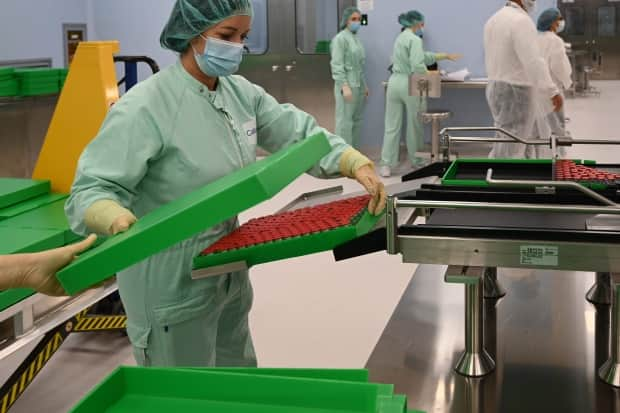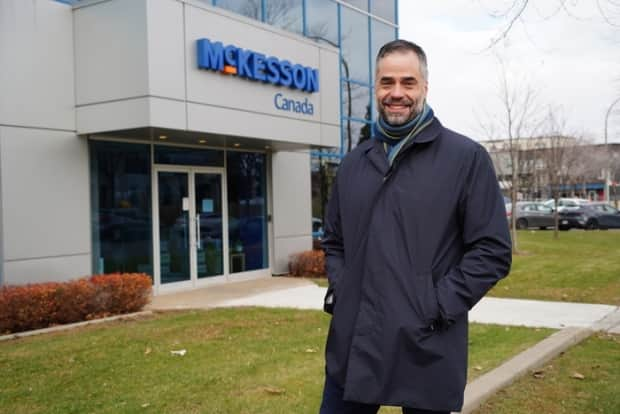What Quebec's COVID-19 vaccination campaign might look like and the challenges to come

It's flu season, which means the glass-and-concrete warehouse on an industrial stretch of Pie-IX Blvd. in Montreal's north end is buzzing. Forklifts are trundling to and fro.
It's the sort of secure building — owned by the medical distributor McKesson Canada — that comes in handy if you're preparing mass immunization for COVID-19.
It's expected that campaign will begin at some point in early 2021, but what will it look like in Quebec?
There are several clues: new federal guidelines suggest health-care workers and vulnerable elderly populations will probably be at the head of the line. In all likelihood, people will need to be injected twice, so an appointment system will be set up.
Unlike the 2009 H1N1 flu pandemic, which provides a recent blueprint for mass inoculations, it seems unimaginable people will gather in, say, shopping malls to queue for a shot.
The effort will likely involve CLSCs and family medicine clinics, as well as hospital installations. Might pharmacies be involved? Possibly, but those questions haven't been dealt with yet.
Coincidentally, the province moved to a new distribution model for the flu vaccine this fall. It has involved the private sector to a greater degree than in years past and by all accounts it has worked smoothly, with only minimal hiccups.
"We've offered our help. We are in active exchanges with the various levels of government involved so we can be part of the solution," said Jean-Philippe Blouin, McKesson Canada's senior vice-president of pharmaceutical distribution and operations.

As the province gears for a COVID-19 serum — which should arrive this winter if the front-running candidates from Pfizer/BioNTech, Moderna and AstraZeneca/Oxford University win speedy approval from Health Canada — there are still pivotal issues to sort out.
'The main obstacle is not having any data'
Several European countries and multiple U.S. states have already spelled out how they plan to vaccinate their populations — some as early as next month.
If it seems like Quebec and the other Canadian provinces are lagging behind, there are solid reasons for that.
For one thing, Quebec has a large territory to cover.
For another, there are likely to be two, three or more simultaneous rollouts, aimed at different segments of the population.
"What's complicated is there are multiple things that need to happen at the same time," said Dr. Caroline Quach-Thanh, a microbiology and infectious diseases professor at Université de Montréal and chair of the National Advisory Committee on Immunization (or NACI), the external scientific body that advises the Public Health Agency of Canada.
"The first one is to see the data from the vaccines to see in which population we'll use which vaccine."
The Pfizer and Moderna vaccines use similar technologies, but Quach-Thanh said there is comparatively little data on their effect "in the most vulnerable populations, or even in the healthy population for that matter."
It seems likely one or more of the vaccine candidates will prove more effective with some clienteles than others, she said.
The most pressing need is to decide who comes first.
"If we decide we want to start with elderly people in long-term care facilities that's an entirely different strategy than if we want to start with health-care workers in hospitals and clinics," said Quach-Thanh.
The scientists at NACI recently issued preliminary guidance on prioritization, but it will ultimately be up to Quebec public health authorities to decide.
"We don't know yet what's going to be the final distribution model," said McKesson's Blouin. "There are still a lot of unknowns. What we know, though, is that the front-runners ... are going to use frozen or ultra-frozen conditions on their products, which creates some challenges, obviously."

In a white paper issued in September, the company warned "the overall public and private vaccine supply chains in Canada are not equipped to support frozen and/or ultra-frozen COVID-19 vaccines at scale."
But that's changing.
Health Minister Christian Dubé said recently the province has arranged for the purchase of 60 specialized refrigeration units. As of September, McKesson, one of the largest pharmaceutical distributors in the country, only had one.
The Canadian government has also entered into agreements to buy 100 more, according to the federal procurement department.
There is a low-intensity international scramble to acquire the equipment, which is key to preserving some of the vaccines.
The AstraZeneca Oxford vaccine can be stored between 2 C and 8 C but Moderna's needs to be kept at -20 C and Pfizer's must be kept at the ultra-cold temperature of around -70 C.
"It has to be kept at a specific temperature, it's not just 'get a big freezer and put everything in the big freezer,'" said David Levine, a former junior health minister who managed the vaccine rollout for the H1N1 flu pandemic, as head of Montreal's regional health authority.
It may also be that Pfizer and the other vaccine providers decide to deliver their product directly on a just-in-time basis rather than providing a stockpile that can be kept in facilities like McKesson's or the provincially-owned medical depots.
But Quach-Thanh says it's not how the health-care system here is used to doing things.
"We don't necessarily have a good handle on who is going to show up the next day," Quach-Thanh said. "Yes, you can book appointments but you have no-shows. It would be very regrettable to have vaccines go to waste."
A logistical challenge
One person who will play a part in ironing out the logistics: Jérôme Gagnon, Quebec's assistant deputy minister of health.
Dubé appointed the operations specialist on Oct. 19. Gagnon has spent the past two decades in the Public Security department. His background is in civil security and anti-terrorism.
Quebec's Health Ministry declined to make Gagnon available for interviews, citing his busy schedule.
On Tuesday, Dubé said the current flu vaccination campaign has managed to reach 200,000 people per week, and that his department is discussing options to scale that up quickly depending on the availability of COVID-19 vaccines.
"Are we going to go to the pharmacists, or other medical professionals ... we're in the middle of preparing for that. Those discussions have started. That means in the coming weeks not only will we be ready, I would tell you we already are," the health minister said.
There are complex issues to manage in any vaccination effort, for example, the winter rollout will be complicated by the fact that most of the leading candidate vaccines will require two injections, with the second coming between two and four weeks after the first.
Levine said the good news is Quebec's health-care system — despite the perennial staff shortage it faces — is well-equipped to organize a mass inoculation. Centralization, usually something to be feared and loathed by regional health administrators, is a good thing in this case, he said.
"I don't think the logistics today is a problem," he said.
It also helps that another substantial piece of the puzzle, namely millions of needles and syringes, is already taken care of, courtesy of the federal government.
Then, there's the issue of who wants the vaccine.
"Everyone is going to want the vaccine and they're going to want to get it as soon as possible," Levine said. "There might be parts of the population that say I'm going to wait and see that the vaccine works well. And those will be the main challenges."
Though the health system doesn't have a surplus of nurses, Levine said the government showed this past spring that it's possible to temporarily re-allocate staff, if necessary.
Lessons from the past
The H1N1 episode is instructive, even though it was a far different situation, in that the pandemic never really took off.
"We were lucky," Levine said.
The government also learned the importance of clear communication.
"Throughout the whole process remain very transparent, very open. It'll be a moment of intense movement in the population when the vaccine is made available," Levine advised.
In 2009, as today, there were multiple vaccines and one drug in particular, the antiviral Tamiflu, was in heavy international demand.
"Everybody was nervous: 'Are we going to get it? What about the hoarding? Who's stockpiling?'"
The lesson, in Levine's view, was clear.
"You need to be careful that in that type of scenario there is an equal distribution of the vaccine, and it isn't related to social class, it isn't related to parts of the city rather than other parts of the city, parts of the country rather than other parts of the country," he said.
Dividing up the doses
Canada has a contract for 20 million doses each of the AstraZeneca, Pfizer and Moderna vaccines, and options to acquire 56 million more of the Pfizer and 36 million of the Moderna.
In all, the federal government has agreements in place for 350 million total doses from seven manufacturers, including Quebec City-based Medicago.
The blanket-tugging has already started.
Last week, Ontario plainly stated that it expects to receive 1.6-million doses of Pfizer vaccine and 800,000 of Moderna in the first three months of 2021.
Ontario Health Minister Christine Elliott lifted the cover on how much Canada expects to receive as a whole between January and March: four million of the first and two million of the second.
Her Alberta counterpart quickly staked a public claim to about 900,000 doses.
Last week, Quebec's public health director Dr. Horacio Arruda stated plainly that Quebec will ensure no other province claws into its per capita share.
There should be enough to go around, although the provincial Health Ministry indicated in an email that it expects limited quantities of serum at first.
WATCH | One man's struggle with COVID-19
Quach-Thanh suggested the vaccination campaign needn't be mandatory, and pointed out children won't be vaccinated, at least not to start, because "there is no data whatsoever, they haven't been enrolled yet in phase three studies."
Also, there may be a popular misconception about the benefits the vaccines will provide.
Quach-Thanh said it's still not clear the vaccine has "any capacity to mitigate transmission."
In other words, the vaccine can and does protect against symptomatic and acute illness from COVID-19, but it may not prevent a pre-symptomatic person from spreading the coronavirus.
Thus, the key is to provide it to those people who face the greatest risks.
"To me, the overall goal of this vaccination program is not herd immunity, it's individual protection of those who are vulnerable and those who need to be protected," she said, later adding "you're going to vaccinate those whose working and living conditions put them at higher risk of infection, regardless of their risk of complication."

